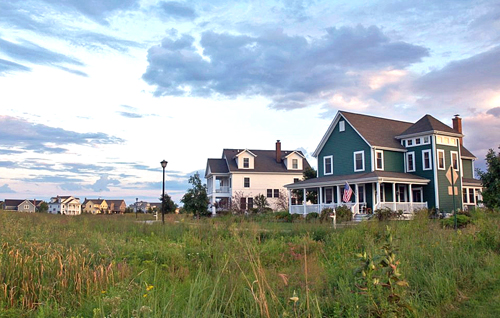Sustainable Community Conserves Illinois Land
chinagate.cn by Victoria Cole, July 15, 2015 Adjust font size:
Undertaken by a group of local developers on a mission to save a previous farming site 46 miles northwest of Chicago from a planned traditional development project, the neighborhood of Prairie Crossing has been a role model for sustainable development for over two decades.
The 667-acre property in Grayscale, Illinois, United States now houses 398 single family houses and 36 condos, as well as a community farm, a charter school and several retail stores. Development was located in such a way that protects native vegetation and other environmental properties, and most houses feature expansive views of open land. As an Urban Land Institute Award Finalist, the ULI had this to say on the project, "[Prairie Crossing] demonstrates how ecologically sensitive development can be used as a tool for the conservation of land that is threatened by inappropriate land uses."

Several of the Prairie Crossing homes [Photo credits: Google Images]
Construction of the community began in 1993 without the typical practice of contracting out construction services. The newly-formed "Prairie Crossing Holding Corporation" acted as its own builder and set in motion ten principles to guide their development: environmental protection and enhancement, a healthy lifestyle, a sense of place, a sense of community, economic and racial diversity, convenient and efficient transportation, energy conservation, economic viability, aesthetic design and high quality construction and lifelong learning and education.
Prairie Crossing homes use about 50% less energy than modern homes. This is due to the specifics of construction overseen by the project. Every home contains thicker insulation formatted within the exteriors, roofs and basements. Additionally, all windows are also better suited to sustain internal temperatures as ever house is also fitted with a 90% efficient condensing gas furnace, a 75% efficient power-vented gas water heater and a supply fan ventilation system.
Even though the community still focuses on energy efficiency, they do utilize renewable energy. Prairie Crossing's wind turbine generates 30,000 to 40,000 kilowatt-hours (kWh) per year, which is allocated to power the organic farm's greenhouses, lights, and washing and cooling system. Excess energy is sold the local energy provider. Some Prairie Crossing homes have also been retrofitted with solar installations, hot water and photovoltaic panels, and the community’s larger buildings are LEED certified.
Prairie Crossing also upkeeps an inclusive Stormwater System that was transferred to the residential management by, according to a University of Minnesota case study, "emphasizing the community benefits rather than focusing on the scientific principles underlying good stormwater techniques." The study also reveals that, "Residents related much more easily to aesthetic and environmental considerations, and stepped in to take care of it."
The community also works with the homeowners association's recycling and composting programs and participates in educational programs offered by the Liberty Prairie Conservancy, the Prairie Crossing Institute, and the community-led organic "Learning Farm." Addtitionally, Prairie Crossing encourages residents to walk or bike using trails connecting to two train stations, two higher education centers, the public high school, the Liberty Prairie Reserve, and other local stores and restaurants.
Source: The University of Minnesota

